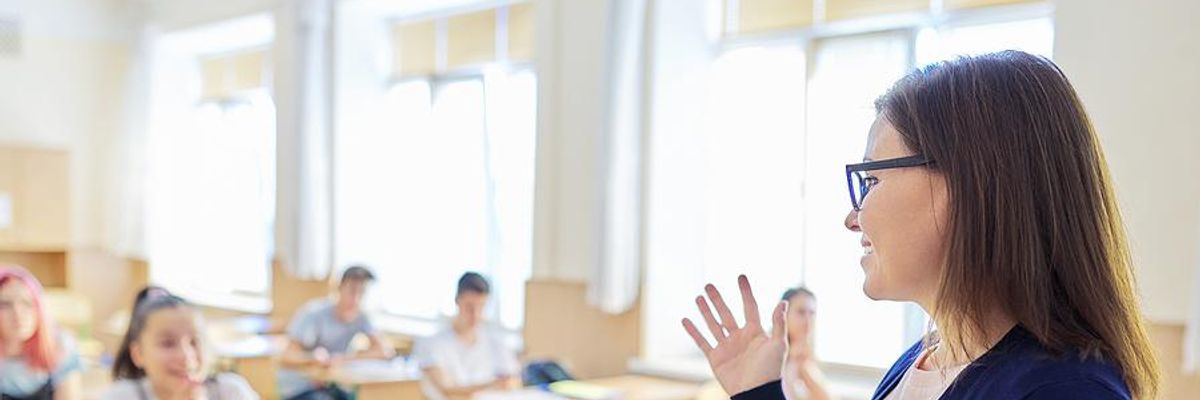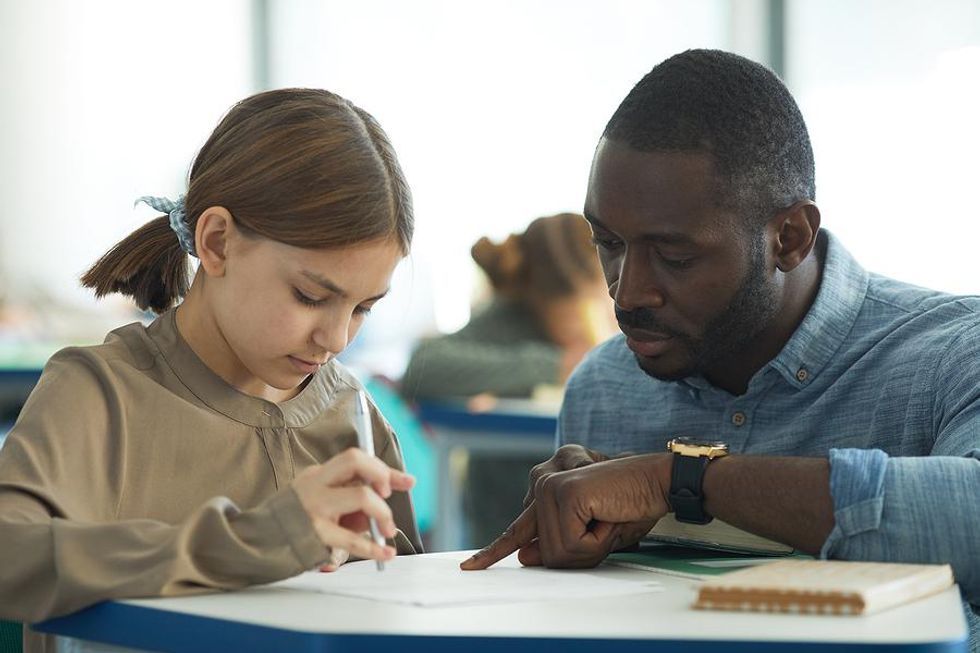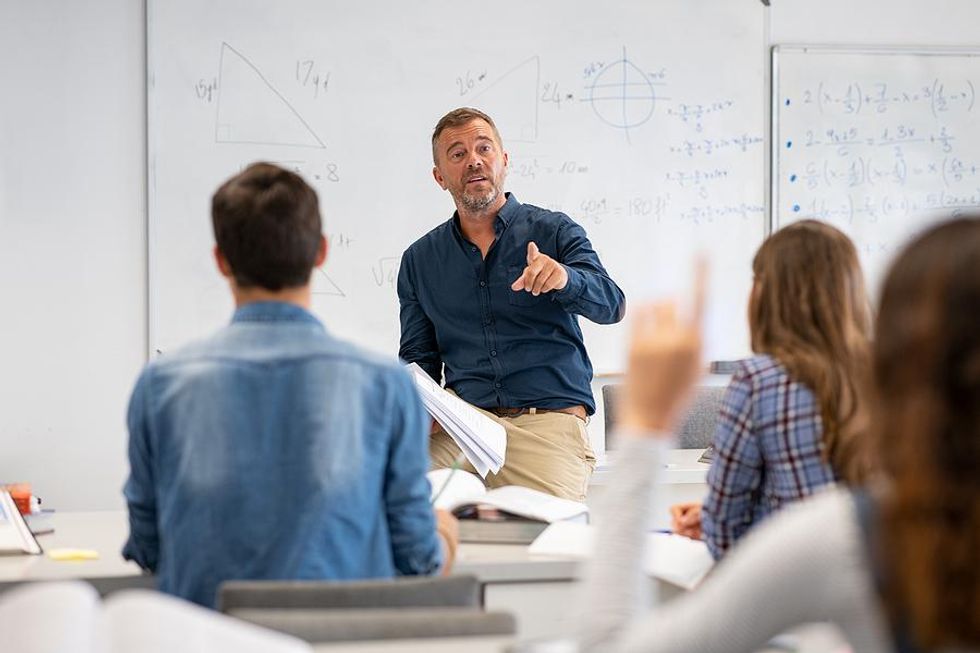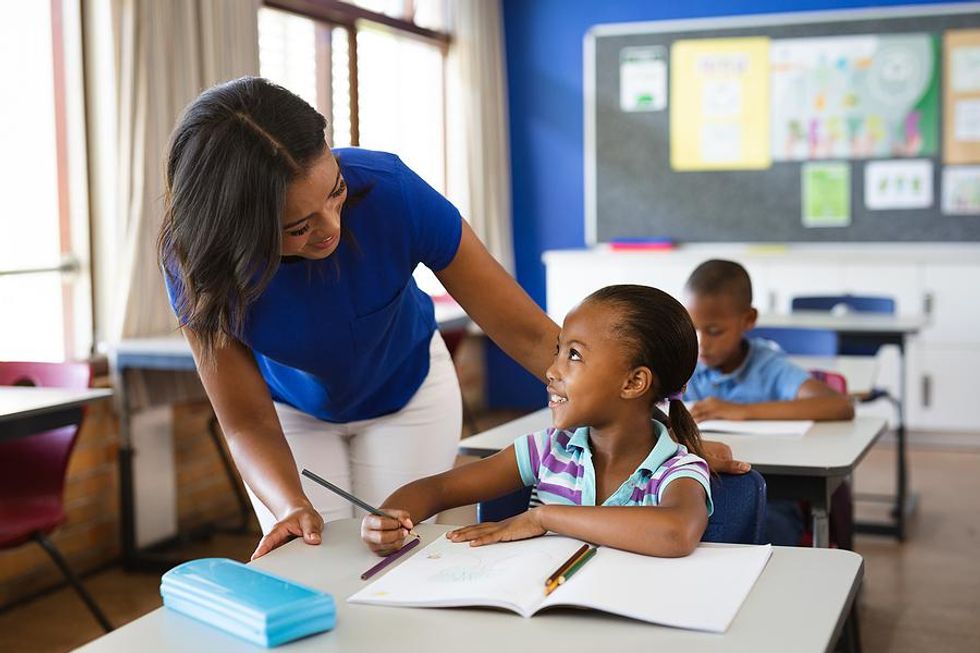
My grandparents owned a two-story walkup in Brooklyn, New York. When I was a child, my cousins and I would take turns asking each other questions, Trivial Pursuit style. If we got the question correct, we moved up one step on the staircase. If we got the question wrong, we moved down one step. The winner was the person who reached the top landing first. While we each enjoyed serving as the “master of ceremonies on 69th Street,” peppering each other with rapid-fire questions, I enjoyed the role of maestro the most of all my cousins. I suppose I was destined to be an educator.
I think some of us, like me, go into teaching because a part of us likes being that helper who is also the center of attention, the sage. This is how we get our fix. However, what I did not realize when I first became a teacher, but understand now, is that it is not about how much knowledge I have as a teacher but how well I can help others not only process and retain information but also develop their own intellectual curiosity.
If the goal of schooling is for every student to learn, these would be the 10 facts about teaching that I would want every teacher to know as they embark on their professional journey:
1. Every Classroom Should Belong To The Students Within It

Bigstock
Less teacher and more student. In my consulting practice, I like to joke with teachers that they should come to school tired from planning and students should leave school tired from thinking/doing. Within lesson plans, the teacher should consider how they will engage students individually and collectively in peer-to-peer discussion. Plan out rigorous guiding questions to anchor these student discussions. As teachers, ask yourself when planning if you must be the one presenting content or if students can learn the same content independently and vis-à-vis their classmates. Instead of presenting the content, spend time curating resources that students will need to analyze the content. Ensure that resources will resonate with students be that by interest and/or cultural background.
2. Be Ready To Pivot Instruction At A Moment's Notice

Bigstock
Meet students where they are in their learning. Use quick checks on understanding during instruction to decide if you should pause to clarify content/vocabulary and eliminate any student misconceptions. Instead, so many of us charge ahead with our lesson plans, despite evidence that students are not retaining information, fearful that we will not “get through” the curriculum, particularly at the middle and high school levels. However, if we speed through content and students remain befuddled what good then was this exercise? Paper and pencil tests, as well as other formal summative assessments, are important indicators of learning but only after the fact. Use checks on understanding during learning when there is still time to affect student learning outcomes. Even when teaching older students and adults, never assume that students “should” know something.
3. Anticipate Student Confusion

Bigstock
Plan for it in advance! When designing lessons, consider everything and/or anything that could go wrong when delivering it. Will students not understand what they are supposed to do? Make sure then to craft a how-to document or anchor chart. Will students bicker when working in pairs or groups? Ensure that you provide students with accountable talking stems. Will some students during group work do all the physical and cognitive heavy lifting and others not? Then, assign each group member an individual role or task. Don’t wait for a student to approach you with their questions and/or concerns. Even adults do not like to “look stupid.” Use checks for understanding and more formal assessments to determine student needs upfront.
4. The Curriculum/Textbook Is Not The Lesson Plan

Bigstock
Your students change every year. So should how you teach. Therefore, you need to create a lesson plan for each lesson every year. This point is related to the second one. While the core content being taught may remain the same from year to year, hence justifying the use of a specific curriculum or textbook over a period of several years, how ready students are in accessing that content will vary from year to year and by student to student. You may need to provide academic scaffolds and supports in any given year (much like the physical scaffolds that support a building while it is being built) to ensure that students not yet ready to meet a learning objective can, ultimately, reach that objective without that learning intention being dumbed down. Conversely, you may have several students within a given year who require additional enrichment.
5. Don't Blame Students For Non-Compliance

Bigstock
If Muhammad won't come to the mountain, then the mountain should go to Muhammad. Making learning relevant to students is important. Draw upon student background knowledge and interests when introducing new concepts. Allow students some choice in how they are to learn a particular concept and/or idea as well as how they demonstrate their knowledge of content and/or skills. Use your scholarship data to determine if certain students are not complying because they might be either bored or frustrated with the content. If a student tells you that they are struggling in learning material a certain way, be open to changing instructional practices to better align with the student’s learning profile.
6. The Primary Role Of A Teacher Is To Be A Mentor To A Human Being

Bigstock
Often, when we start our careers in education, particularly those interested in teaching high school students, we have a narrow concept of what our role is going to be—teacher of social studies, science, math, etc. Granted, too much focus on assessments in math and ELA, particularly, reinforces this concept unnecessarily. Still, philosophically, educators of all content areas and grade levels are in the unprecedented position of having real impact in supporting all aspects of a student’s development. Do you help students develop life skills in critical thinking, self-analysis, collaboration, and communication, for example, while also teaching content? How might students hone their social-emotional skills through the learning activities that you design? While some of our students might pursue careers within the content area we teach, the majority will not. But that does not mean that we don’t have profound impact for good, or bad; this depends on how we make students feel about their learning. I wish I could have a “do-over” with a few students whom I feel I failed.
7. Teaching Is A Team Sport

Bigstock
I would be rich if I had earned even a quarter for each time, as a consultant, I encountered a locked classroom door in an upper school and saw windows looking into classrooms covered over with pieces of paper. Instead, be curious about learning best practices from colleagues. Remember the goal is to help all students learn. This means we need to be consistently considering “how” we teach—the processes through which we ask students to learn and the materials and models for learning that we use. Consider peer walkthroughs, engage in data-informed professional learning communities, involve yourself in a collaborative book study, and participate in looking at student work protocols with your co-teachers. Replicate best practices in your classroom. If the administration has not set up the systems and/or processes to allow for these activities, at a minimum, find an accountability partner/master teacher in whose class you may sit and observe and with whom you can share teaching ideas. If we ask students to be curious and to engage in learning, we, too, need to be models for this practice.
8. Let Students Struggle (A Little)

Bigstock
Yes, you can kill through too much kindness. You can't go vote, attend college with, or join in on job interviews with your students. Don’t create learned helplessness. Students need to think critically for themselves. Don't tell students what to think but pose cognitively deep-guiding questions and set up conditions/discussion protocols to help students develop skills around how to think/metacognition. Ensure that learning tasks are intellectually rigorous, respectful, and make thinking visible. Even elementary students can work independently and collaboratively. Assess what students know and still do not know as they work, and then reengage to address any misconceptions.
9. Stress In Class Is Okay (Sometimes)

Bigstock
As a teacher and trainer of teachers, I often will cold call on people to respond to a question prompt. I also have learners select the next person to answer. I recognize that this raises stress levels. But that is not in itself bad when it comes to teaching and learning. And training adults is not so different from teaching children in this regard. Requiring learner “presence” gives one a truer sense of what is and is not resonating and it provides learner accountability. Growth comes from engagement with ideas, people, and resources in addition to self-reflection and extension of our boundaries.
10. We Are All Literacy Teachers

Bigstock
Reading, writing, and speaking are crucial skills to have if we are to communicate effectively. If students do not understand key vocabulary, text details that support a claim, or even the author’s point of view/inferences, how can they ever realistically learn the specific academic content you are teaching? Know your students’ readiness levels as it pertains to literacy and make accommodations to content, process, and/or student product accordingly.
If you are struggling in increasing student achievement, chances are that you can further hone your current teaching practices in one or more of the above areas. To learn how to do this, please feel free to reach out to me at John Schembari, Ed.D. | LinkedIn.
If you would like additional ideas on how to impact student lives without sacrificing your own, and have a life teaching, check out my quick hack teaching courses here. You can also reach me on LinkedIn.
- How To Answer The Top 5 Interview Questions For Teachers - Work ... ›
- 4 Things College Doesn't Teach Us About The Job Search - Work It ... ›
- The 3 Best Resume Tips For Teachers - Work It Daily ›
- 6 Things To Know Before Becoming A Teacher - Work It Daily ›
- 5 Planning Tools For Mastering The Curve Balls Of Teaching ›
- 3 Reasons For The “Big Quit” In Teaching - Work It Daily ›
- 4 Strategies Educators Are Using To Revolutionize Teaching - Work It Daily ›
- What Teachers Should Know Before Interviewing With Schools - Work It Daily ›
- 5 Common Teaching Mistakes That Stunt Student Growth - Work It Daily ›
- How To Help Newly Arrived English Language Learners Thrive - Work It Daily ›
- 10 Things To Look For In A "Perfect" Classroom - Work It Daily ›

 Bigstock
Bigstock Bigstock
Bigstock Bigstock
Bigstock


